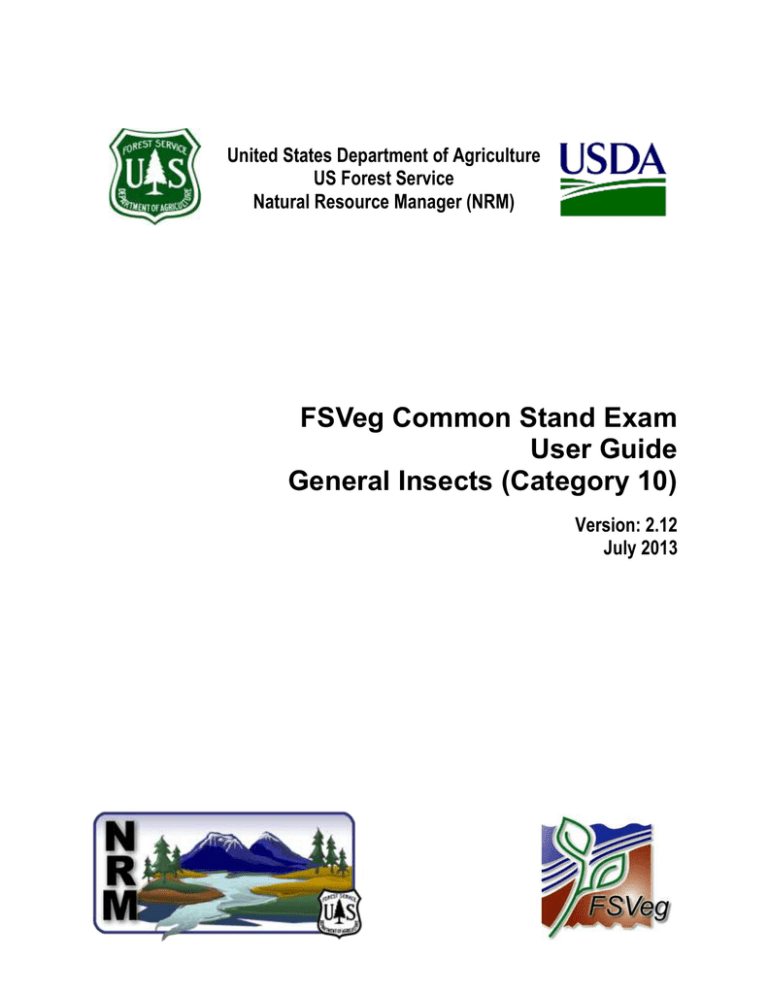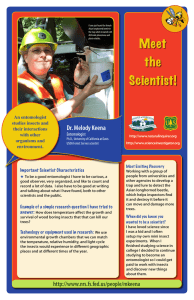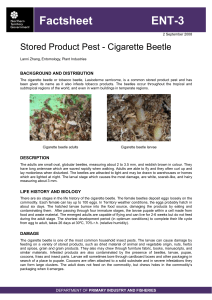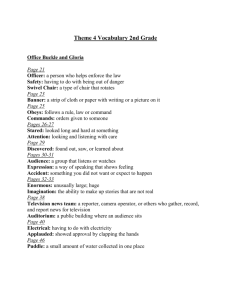FSVeg Common Stand Exam User Guide General Insects (Category 10)
advertisement

United States Department of Agriculture US Forest Service Natural Resource Manager (NRM) FSVeg Common Stand Exam User Guide General Insects (Category 10) Version: 2.12 July 2013 TABLE OF CONTENTS (10-001) Thrips ................................................................................ 2 (10-004) Chinese Rose Beetle .......................................................... 2 (10-005) Rose Beetle ....................................................................... 2 (10-006) Coconut Hispid Beetle ....................................................... 2 (10-007) Clerid Beetle ...................................................................... 3 (10-009) Green Rose Chafer ............................................................. 3 (10-010) Allegheny Mound Ant ........................................................ 3 (10-012) Stick Insect ....................................................................... 4 (10-013) (Hulodes cranea)............................................................... 4 (10-015) Caroline Shortnosed Weevil............................................... 4 (10-016) Coconut Rhinoceros Beetle ................................................ 4 (10-017) Bagworm Moth .................................................................. 5 (10-018) Coconut Palm Weevil ......................................................... 5 (10-019) Scarab ............................................................................... 6 (10-020) Ash White Fly .................................................................... 6 (10-021) (Steremnius carinatus) ..................................................... 6 (10-022) Pyralid Moth ...................................................................... 7 (10-023) Wood Wasps ...................................................................... 7 FSVeg Common Stand Exam User Guide i Insects & Diseases: General Insects (Category 10) (10-001) THRIPS Hosts: Slash pine, jack pine, chestnut oak, hawthorn Injury: Damage to the strobili consists of punctures and abrasions on the scales and bracts of flowers and conelets. Heavy infestations result in shriveled conelets and flowers. Description: Thrips are small slender-bodied insects, usually from 0.05 to 5.0 mm long. Adults are either wingless or have four long, narrow fringed wings with few or no veins. The mouthparts are of the sucking type. (10-004) CHINESE ROSE BEETLE Species: Adoretus sinicus Hosts: Food crops and ornamental plants Range: Pacific Islands including Hawaii Injury: Adults feed on plant foliage at night, creating a lace-like or shot-withholes appearance on leaves by feeding on plant tissue between leaf viens. In severe cases most leaves are skeletonized. Description: Adults are sturdy, pale reddish brown beetles, about ½ inch in length, covered with fine white hairs that give the beetle a grayish appearance. (10-005) ROSE BEETLE Species: Adoretus versutus Range: Pacific Islands including Hawaii (10-006) COCONUT HISPID BEETLE Species: Brontispa longissima Host: Coconuts Range: Pacific Islands including Hawaii FSVeg Common Stand Exam Users Guide 2 Insects & Diseases: General Insects (Category 10) Injury: This beetle attacks coconut spikes before they emerge from the tree. When the damaged spike emerges, parts of it are already brown, dead, and decayed. Beetle damage causes the irregular form of fronds and the vacant spaces where midribs should be. In cases where the beetle reaches the bud, bacteria will act on the feces they deposit and cause rotting. This will severely stunt the tree or cause mortality among younger coconuts. Description: The larvae of the black, elongated beetle are reddish orange and deposited between leaf blades in the young and tender spikes. (10-007) CLERID BEETLE Species: Cleridae Injury: Injury is to other bark beetles, rarely to the host tree. The larvae travel down the tunnels of their host, eating one larva after another. Description: The adults are active, antlike, brightly-colored hairy beetles about 3 to 13 mm long. They feed on adult beetles. The larvae live in galleries and tunnels of bark beetles and woodborers. Adults are distinguished by their 11-jointed and serrate antennae . Larvae are soft-bodied and thin textured. (10-009) GREEN ROSE CHAFER Species: Dichelonyx backi Hosts: Ponderosa pine, Douglas-fir, fir, spruce Range: Rocky Mountains and the Pacific Coast Injury: Adults feed upon the needles, often leaving only the midrib. In California, it feeds upon immature cones of ponderosa pine and reduces seed production. Description: Adults are elongated, broadly convex dorsally. The thorax is not grooved. Wing covers vary from metallic green to shiny brown. The body may be brown or black. The mandibles of the males are elongated and sometimes prominently toothed. They breed in decaying stumps or logs. (10-010) ALLEGHENY MOUND ANT Species: Formica exsectoides FSVeg Common Stand Exam Users Guide 3 Insects & Diseases: General Insects (Category 10) Host: Eastern white pine, red pine, Scotch pine, red cedar, spruce Range: Eastern and northeastern states Injury: Nests in the ground and constructs mounds up to 4 feet in height and 6 feet across. All vegetation, except large trees, may be destroyed in an area 40 to 50 feet in diameter. The vegetation is not eaten, only destroyed to prevent shading of the mound. Trees from 2 to 15 years old are especially susceptible. Description: Adult is about 3 to 6 mm long. The head is reddish brown and is about as wide as long. (10-012) STICK INSECT Species: Graeffea crovanii Range: Pacific Islands including Hawaii (10-013) (Hulodes cranea) Species: Hulodes cranea Range: Pacific Islands including Hawaii (10-015) CAROLINE SHORTNOSED WEEVIL Species: Lophothetes spp. Range: Pacific Islands including Hawaii (10-016) COCONUT RHINOCEROS BEETLE Species: Oryctes rhinoceros Host: Coconut Range: Pacific Islands including: Fiji, Papua New Guinea, American and Western Samoa, Tokelau, Tuvalu, Wallace Island, and Hawaii Injury: The adult beetles burrow into the palm crown to get sugary liquid from the soft tissues and thus damage the unopened inflorescence. As a result, the nut production can be greatly reduced. FSVeg Common Stand Exam Users Guide 4 Insects & Diseases: General Insects (Category 10) Description: The female beetles deposit their eggs singly as deep as 5 to 15 cm underneath the surface of rotting logs and vegetation. The eggs are ovoid in shape when laid and they become almost spherical when they absorb water. The color will change from creamy white to yellowish brown as development advances. They hatch in 8 to 12 days. (10-017) BAGWORM MOTH Species: Psychidae Host: Emglemann spruce, pine, sycamore, maple, persimmon, red cedar, sweetgum, cottonwood, poplar, aspen, oak, black locust, willow Range: Mostly found in the eastern and southeastern states Description: Members of this family have a habit of spending the entire larval stage within silken bags. The bag is strong, tough and camouflaged with leaves and twigs. An opening is maintained at the top of the bag for moving, feeding, or enlarging the bag. Excrement drops out of the bag through a hole in the bottom. (10-018) COCONUT PALM WEEVIL Species: Rhobdoscelus asperipennis Host: Coconut palms Range: Pacific Islands including Hawaii Injury: Drooping from the bottom fronds, drying up and browning of those fronds, most of the coconuts drop, blackening of the flowers, the crown emits a rotten stinking smell, and finally the top topples over and the tree is dead. Description: Giant 3-inch flying black weevil that is attracted to wounded/dying or young trees. It likes to colonize in a tree’s crown and it lays its eggs at the base of the inside of the petioles or in wound holes in the trunk. The eggs hatch into larvae that eat through the palm tree and within 30 days they reach the size of a small sausage at which time they usually eat the heart of the tree and thus kill it. When in epidemic numbers, the weevils only kill a maximum of 20% of the tree population. FSVeg Common Stand Exam Users Guide 5 Insects & Diseases: General Insects (Category 10) (10-019) SCARAB Species: Scarabaeidae Host: Pines Injury: Attacks cones and seeds Description: Adult scarabs are generally very robust, with antennae terminating in plate-like segments. Larvae are robust, typical C-shaped, white brubs with obvious thoracic legs. (10-020) ASH WHITE FLY Species: Siphoninus phillyreae Host: Ash, hawthorn Range: Pacific Islands including Hawaii and California Injury: Heavy infestations lead to wilting, leaf drop, smaller fruit, large quantities of sticky honeydew and sooty mould growing on the host. Description: Pupae are small immobile structures, 1.5 mm long, clustered on the underside of leaves, have grayish bands on a pale whitish body. Adults have slightly mottled wings, pale whitish fly. Eggs are laid on underside of leaves. (10-021) (Steremnius carinatus) Species: Steremnius carinatus Host: Douglas-fir, Sitka spruce Secondary host: Hemlock, true fir Range: Coastal forests from Alaska to Oregon Injury: Adults feed on many kinds of dead plant material. Larvae develop in the phloem if slash and in the roots of dead conifers. Sometimes the adults girdle 1- and 2-year old seedlings at the ground line. Description: The rough-surfaced, dirt colored adults have scattered patches of rusty scales and are 7 to 10 mm long. FSVeg Common Stand Exam Users Guide 6 Insects & Diseases: General Insects (Category 10) (10-022) PYRALID MOTH Species: Thliptoceras octoquttale Range: Pacific Islands including Hawaii (10-023) WOOD WASPS Species: Siricidae spp. Injury: A few species have been recorded attacking vigorous trees, but they usually prefer trees or parts of trees that are dead or in a badly weakened condition. Description: Members of this family have a hornlike projection on the last abdominal segment of the adult. It is short in the male, but long and pear-shaped in the female. Adults are medium to large and usually metallic blue or black in color. FSVeg Common Stand Exam Users Guide 7 Insects & Diseases: General Insects (Category 10)








